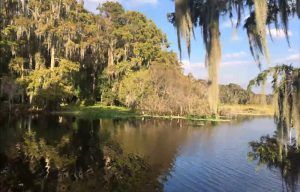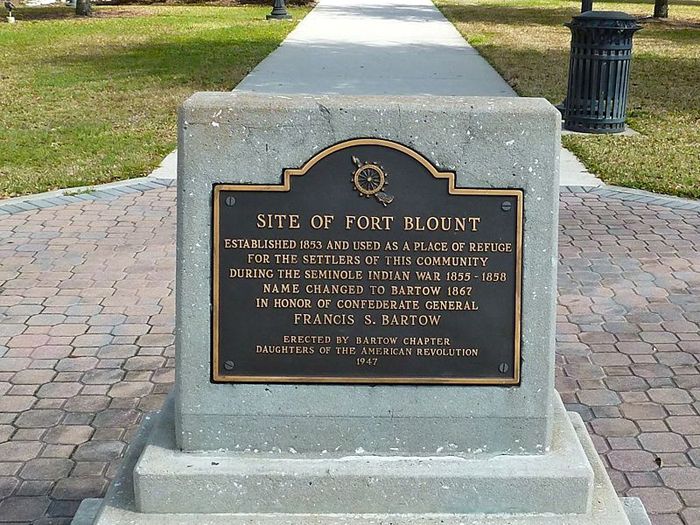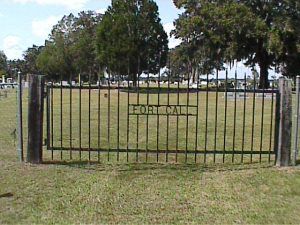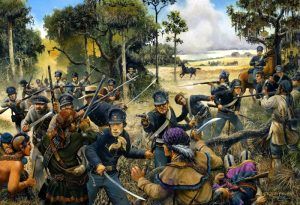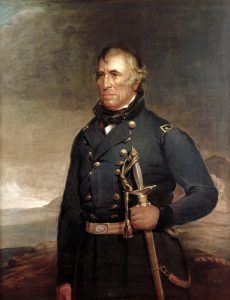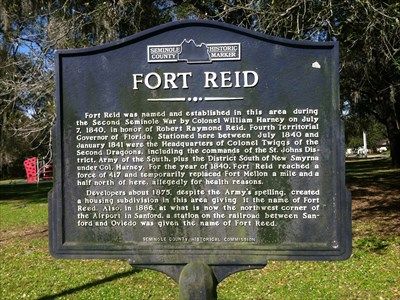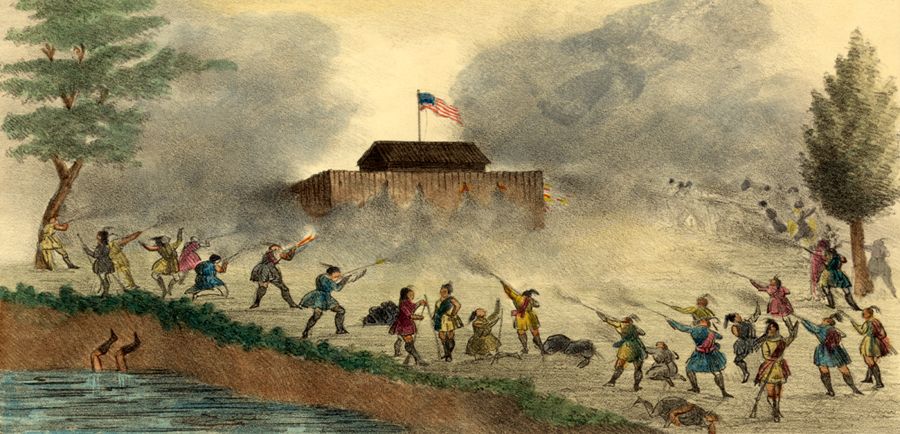
Attack of the Seminole on a blockhouse in Florida, Gray & James, 1837
Fort Arbuckle – Fort Arbuckle was a fort established on the northeast shore of Lake Arbuckle, 12 miles east of Fort Clinch in Polk County, Florida. It was built in 1850 as part of a ring of civilian and military posts created to protect settlers in the interior of southwest Florida. That year, it was also used as a staging area to move many of the Seminole Indians westward. After 60 men, women and children were assembled at the fort, they were put aboard the steamer Fashion, bound for New Orleans, Louisiana in February 1850. There are no remains of the fort today.
Fort Barker – During the Seminole Wars, there was considerable fighting taking place along the Steinhatchee River in northern Florida. Three forts, including Forts Baker, Macomb, and Downing were erected in Lafayette County. Fort Barker was located nine miles southwest of Fort Macomb on the west side of the Steinhatchee River, near modern-day Cooks Hammock, Florida.
Fort Blount – In October 1851, Redding Blount led a party of 21 white pioneers and 12 black slaves to the area and settled west of current downtown Bartow. The settlers, which included Blount’s four sons and their families soon established a blockhouse for their protection. The settlement was named Fort Blount after the fort but was later renamed Pease Creek until it was named Bartow in 1867. The blockhouse was probably abandoned as a fortification before the end of the Third Seminole War in 1858. There are no remains today but the site is marked by a small monument in the Fort Blount Park.
Fort Butler – Located on the west bank of the St. Johns River, Fort Butler was built in 1838 during the Second Seminole War. Named after the surveyor-general of the Florida territory, Robert Butler, it consisted of a crude log stockade and barracks for the garrison. The Fort was one of the military installations designed to protect the St. Johns River, which served as an important artery of communication with the garrisons in central Florida. On the opposite bank, near the frontier settlement of Volusia, stood Fort Call. There are no remains of the fort today but a historic marker is located near the St John’s River Bridge on the side of State Road 40, in Astor, Florida.
Fort Call – This U.S. Army post was established in December 1836 during the Second Seminole War by Captain John L. Gardner in present-day Worthington Springs, Florida. It was established after the Battle of Wahoo Swamp in November 1836 and named for General Richard K. Call, the Florida Governor and commander during the battle. During this time, many of the early settlements in Union County were attacked by the Seminole and people sought protection at the fort. The fort was abandoned in March 1838. Several years later, in 1845, a Methodist Church was built near the fort. Though there are no remains of the fort or the church today, the FortCall Cemetery, which was established by the church, still exists.
Fort Capron – This U.S. Army post established in March 1850 by Captain Erastus A. Capron, 1st U.S. Artillery, in the present-day town of St. Lucie, Florida. It was built to replace old Fort Pierce, which had burnt down in 1843 after being decommissioned. The settlement of St. Lucie grew up around the fort. The post was last commanded by Captain Abner Doubleday when it was evacuated in June 1858. The post was one of the last Seminole War forts to be abandoned. Nothing remains of the fort today, but its location is remembered with a monument in the St. Lucie Village Historic District.
Fort Carroll – A stockade type depot, this post was erected by Captain T.P. Guynn and member of the 8th U.S. Infantry while on a march to the Kissimmee River during the Second Seminole War. Built in January 1841, it was named in honor of Sergeant-Major Francis Carroll who suffered a hero’s death at the hands of Indians near Micanopy. It was abandoned in 1841 in favor of Fort Cummings. The fort was located in present-day Polk County, Florida. There are no remains today.
Fort Casey – A temporary U.S. Army post established in 1850 during the Second Seminole War in Lee County, Florida. It was named for Captain John C. Casey, the Commissioner for the Removal of the Seminole Indians from Florida. It was abandoned the same year it was built.
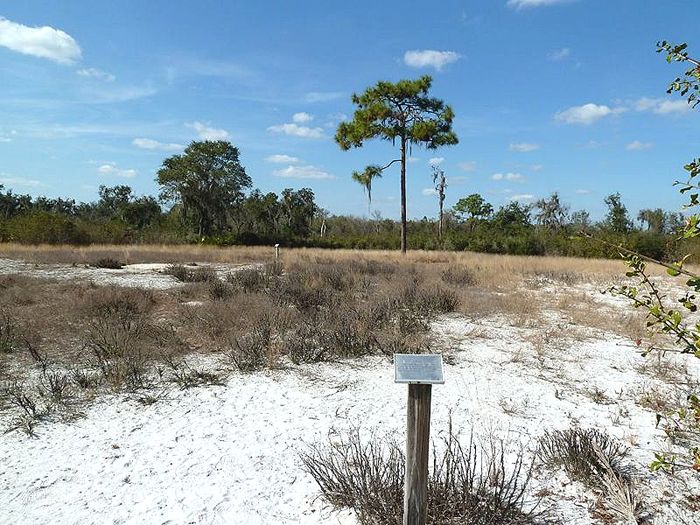
Fort Chokonikla, Florida courtesy Fort Wiki
Fort Chokonikla -Located near Bowling Green in Hardee County, Florida, this post was established in October 1849 in response to hostile Indian attacks in the area. The site was on high ground near the confluence of Paynes Creek and the Peace River and near the Kennedy-Darling trading post. The fort consisted of three square blockhouses for defense and canvas tents for housing. This was the first of several forts built in a chain from the Manatee River to the Indian River. It was abandoned in July 1850 because of the poor health conditions at the site. There are no remains of the fort today. The site is located in Paynes Creek Historic State Park,in Bowling Green, Florida.
Fort Clarke -Originally a U.S. Army post during the Seminole Wars, and afterward a settlement, it was named for Lieutenant Henry Clarke, 5th U.S. Infantry. At this site, crossed the early settlement and military road connecting the old county seats at Newnansville, near present-day Alachua, and Spring Grove with Micanopy. It was abandoned in 1840 but reoccupied in 1861 during the Civil War. The site, which has no remains today, is located in Gainsville, Florida.
Fort Defiance/Fort Micanopy – Located in the present-day city of Micanopy, Florida, both Fort Defiance (1835–1836) and Fort Micanopy (1837–1843) were located here during the Second Seminole War. The U.S. Army first established Fort Defiance in December 1835 after much destruction had taken place in the area. Sugar plantations and homesteads were burned and entire families sought safety in the village of Micanopy. During the summer of 1836, the Battle of Micanopy and the Battle of Welika Pond took place along the road southwest from Fort Defiance to Fort Wacahoota. On August 24, with most of the soldiers sick or wounded, the U.S. Army evacuated the fort and town and all buildings were intentionally burned. Afterward, Fort Micanopy was erected in 1837. This second fort lasted throughout the Second Seminole War until it ended in 1842. It was abandoned in 1843. There are no remains today.
Fort Drum – A U.S. Army post established in 1849 between the Second Seminole War and the Third Seminole War near the present-day town of Fort Drum, Florida. After the end of the Second Seminole War in 1842, the U.S. Army built a network of forts across the central part of the state, with military roads that connected them. Fort Drum was located where two of these roads crossed. It was deactivated on May 28, 1850, but reoccupied in 1856. It was abandoned in 1861 at the start of the Civil War. It was located on the east side of Drum Creek two miles south of the present-day town of Fort Drum. There are no remains today.
Fort Duval – This temporary stockade built in November 1826 to guard the mouth of the Suwannee River. Located about ¼ mile from the Seminole Indian Agency, it was constructed by Captain Francis Langhorne Dade and 120 troops. The fort measured 140 by 130 feet, was six feet high, with portholes for firing. The troops lived in crude lumber huts. It was named for territorial governor William Pope Duval. By 1841, it was gone.
Fort Floyd – A U.S. Army post established in 1838 during the Second Seminole War by Colonel Zachary Taylor in Okeechobee County, Florida. It was possibly named for General Charles R. Floyd who commanded the Georgia Volunteers in south Florida. It was abandoned later in 1838. The post was also known as Fort Lloyd and Camp Lloyd.
Fort Maitland – A U.S. Army Post built during the Second Seminole War in present-day Maitland, Florida. The post was built as a supply depot in November 1838 by Lieutenant Colonel Alexander C. W. Fanning on the military road connecting Fort Mellon with Fort Gatlin. Located on the western shore of Lake Maitland, the fort was named for Captain W. S. Maitland, who was injured during the Battle of Wahoo Swamp in November 1836 and later killed himself after nine months of trying to recover from his injuries. It was abandoned in 1842.
Fort Mason – During the Second Seminole War, troops under the command of Brigadier General Abraham Eustis left Volusia County headed toward the Withlacoochee River as part of military action in response to the December 1835 Dade Massacre. In March 1836 the troops encamped while a bridge was constructed over the Ocklawaha River. They built a fortified stockade about one mile south of the bridge, on the east side of Smith Lake. It was named Fort Mason, most likely to honor Lieutenant Colonel Pierce Mason Butler who led the expedition and after whom Fort Butler, near Astor, was also named. After hostilities ended, Fort Mason became a supply base to support and encourage settlement in the area, which would later become Lake County. With the coming of the railroad in the 1880s, a town on the north shore of Lake Eustis took its name from Fort Mason.
Fort Reid – Fort Reid was named and established in this area during the Second Seminole War by Colonel William Harney on July 7, 1840, in honor of Robert Raymond Reid, Fourth Territorial Governor of Florida. Stationed here between July 1840 and January 1841 were the Headquarters of Colonel Twiggs of the Second Dragoons, including the commands of the St. Johns District, Army of the South, plus the District South of New Smyrna under Colonel Harney. In 1840, Fort Reid reached a force of 417 and temporarily replaced Fort Mellon a mile and a half north, allegedly for health reasons. It was abandoned in 1842 and was occupied on and off by area settlers until it was re-garrisoned briefly in November 1849. It was abandoned for the final time the next month. The site is designated with a historic marker in Speer Grove Park in Sanford, Florida.
Fort San Bernardo – This post was built by Don Bernardo de Galvez, the Governor of Spanish Louisiana. From this post, the Spanish bombarded the English-held Fort George on April 27, 1781, which surrendered on May 9, 1781. Afterward, 15,000 Spanish soldiers initially occupied the fort and later, 1,500-2,000 soldiers were regularly stationed there. As a result of this battle, all of Florida from the Apalachicola River to the Mississippi River passed from Britain to Spain. A historical marker designates the site in Pensacola, Florida at the intersection of North Spring Street and West Brainerd Street.
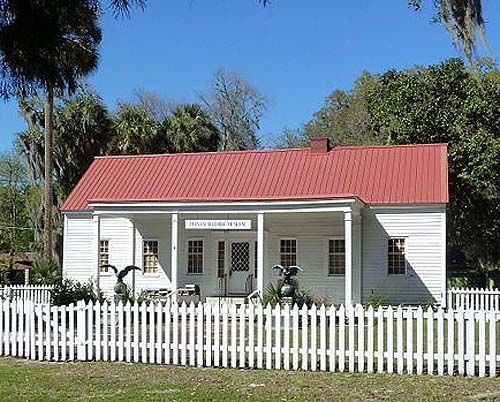
The Fort Shannon Officer Quarters, now serve as a museum in Palatka, Florida, photo courtesy Fort Wiki
Fort Shannon – Established in May 1838, this fort was one of the major quartermaster depots in Florida during the Second Seminole War. It operated under General William J. Worth until he assumed command of the armies in Florida. Military facilities included a hospital, barracks, blockhouses, and stables for more than 400 horses. During the fort’s existence, the town of Palatka was military in appearance and under military control. The fort was abandoned by the U.S. Army in August 1843 after the Seminole had left the area. Afterward, the fort was privately owned and during the Civil War, the officers’ quarters were used as military barracks by Union troops during their occupations of Palatka. Today that building had been moved and still stands at 110 Madison Street in Palatka, Florida and is operated as the Putnam Historic Museum.
Fort Taylor – One in a series of four small, short-lived forts built along the Saint Johns River during the Seminole Wars. These forts were used to garrison troops and protect supplies during War. This post should not be confused with Fort Zachary Taylor, built in Key West, Florida, approximately 280 miles to the Southwest of this Fort Taylor’s location. The future President was a Colonel during the Second Seminole War and served in the Florida campaigns at the same time this fort was in active operation.
Compiled by Kathy Alexander, updated January 2021.
Also See:
Sources:
Key West Art & Historical Society
Roberts, Robert B., Encyclopedia of Historic Forts: The Military, Pioneer, and Trading Posts of the United States, Macmillan, New York, 1988

